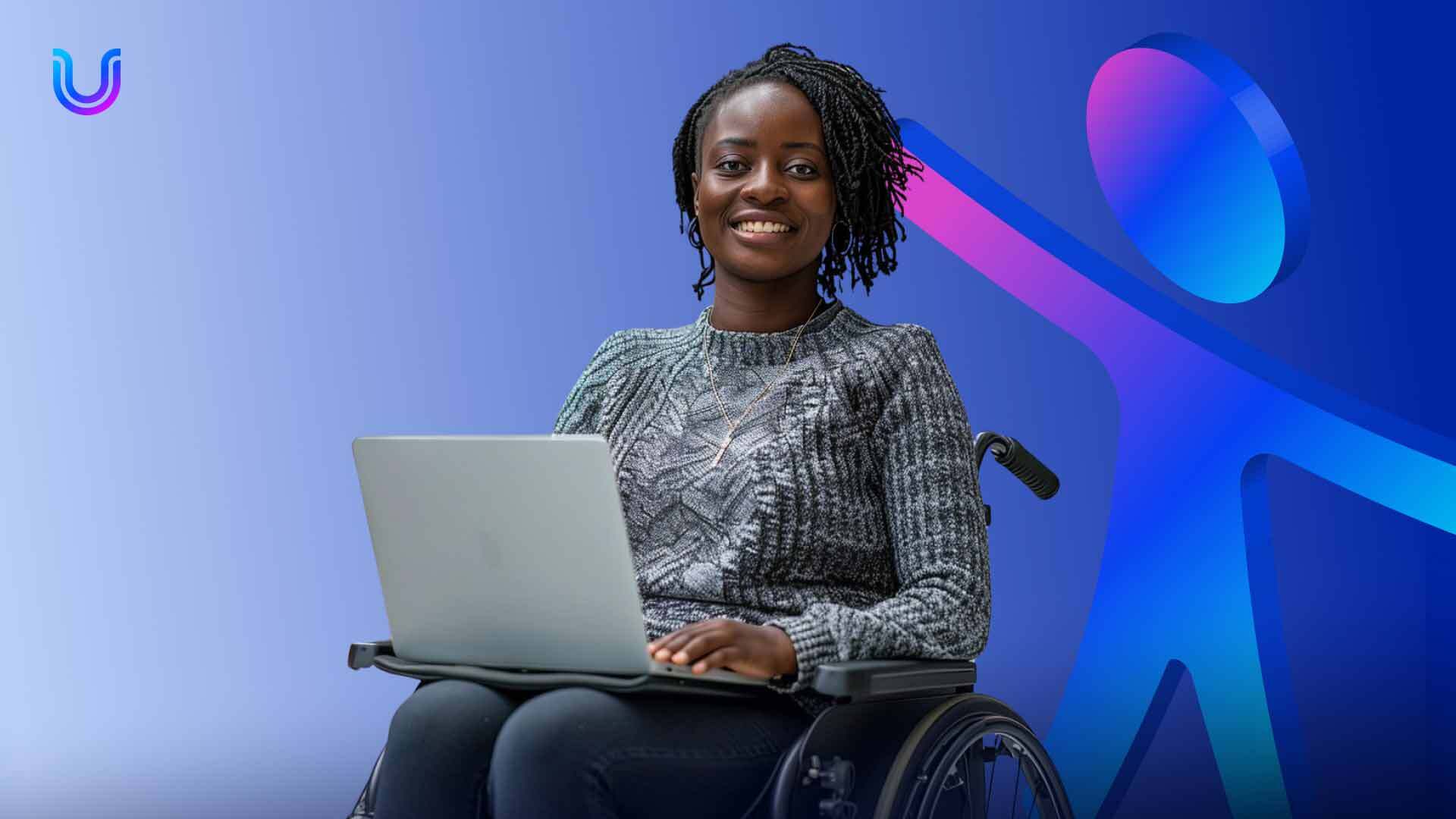Breaking down digital barriers for physical and cognitive disabilities

When we discuss accessibility and inclusivity, the focus often revolves around physical disabilities and visible accommodations like ramps and elevators. However, it’s equally vital to acknowledge disabilities that aren’t immediately apparent. The effects of “invisible” physical disabilities range from minor to significantly life-altering, so recognizing and accommodating them is crucial.
With around 15% of the global population currently living with some form of disability – a number expected to reach 2 billion by 2050 – it’s a formidable challenge to make all kinds of spaces accessible for different types of disabilities. Indeed, these statistics show that disabilities transcend the physical world, landing firmly in the digital realm where the most work must be done.
This blog series is designed to enhance your understanding of inclusivity. It explores ways to dismantle physical and non-physical barriers faced by people with disabilities, including the physically challenged. Let’s clarify the definitions of various disability types to deepen our understanding.
What is the disability spectrum?
Disabilities vary significantly in nature, severity, and impact on an individual’s life. They’re categorized into several types, each including a range of specific conditions:
1. Physical disabilities: These affect mobility or dexterity, including common physical disabilities like spinal cord injuries, amputations, or cerebral palsy.
2. Mobility impairments: Mobility impairments are a type of physical disability, but not all physical disabilities are mobility impairments. Mobility impairments limit a person’s ability to move around freely and easily. These impairments can range from mild physical difficulties with movement to complete paralysis.
3. Sensory disabilities involve impairments in one of the senses, such as hearing loss or visual impairments.
4. Cognitive disabilities: These affect a person’s intellectual functioning and include conditions like traumatic brain injury, Down syndrome, or dementia.
5. Psychological disabilities: These affect a person’s mental health and include conditions such as depression, anxiety, bipolar disorder, and schizophrenia.
6. Neurodevelopmental disabilities typically manifest early in development and can affect a person’s behavior, memory, or learning ability. Common examples include autism spectrum disorders and attention-deficit/hyperactivity disorder (ADHD).
Significantly, each condition can affect two people in very different ways, and understanding these differences is critical to addressing these differences on the web.
What’s the hierarchy of disabilities and physical impairments?
Living with a disability often means facing numerous limitations. However, even within the disability community, some disabilities are seen as more significant than others. This concept of a “hierarchy of disability” shows that certain types of disabilities are sometimes perceived as more “legitimate” or “serious” than others. For example, people with the most common physical disabilities typically receive more acknowledgment and obvious solutions like ramps and elevators.
In contrast, less visible disabilities, such as mental health issues or cognitive impairments, often receive less public understanding and accommodation than people with physical disabilities. This can lead to significant disparities in support and acceptance, inadvertently marginalizing less visible disabilities in advocacy efforts. The good news is that assistive technologies help level the playing field.
Let’s examine the tech that helps people with disabilities avoid feeling excluded or left behind.
How can tech provide physical accessibility for all ability levels?
It’s important to remember that there is no one-size-fits-all solution when building technology that addresses physical impairments, cognitive challenges, and mental health issues, including considerations for physical accessibility. Every user is different and has different requirements. We’ll list a selection of technologies built for various needs across many different sets of circumstances concerning ability and disability:
1. Assistive devices: Technological advances have led to the development of a wide array of assistive assistive technology for people with physical disabilities. For example, screen readers and text-to-speech software help those with visual impairments access digital content, while speech recognition software assists those with mobility impairments.
2. Customization and adaptability: Technology allows for personalization that can accommodate individual needs. Adjustable settings, such as text size, screen contrast, and keyboard configuration, make devices more accessible to people with varying physical and sensory impairments.
3. Communication enhancements: Technologies like real-time captioning and sign language translation apps have revolutionized communication for the deaf and hard of hearing. Similarly, communication boards and speech-generating devices aid those with speech impairments.
4. Cognitive aids: Apps that assist with executive functioning can be invaluable for individuals with cognitive disabilities. These tools help manage time, remember tasks, and streamline decision-making processes.
5. Remote access and telehealth: Technology enables remote services, such as teletherapy and online consultations, making healthcare and professional services accessible to those who face mobility challenges or live in remote areas.
6. Educational technologies: Adaptive learning platforms and educational apps designed to meet diverse learning needs make education more accessible and inclusive for physically and mentally disabled students. These technologies often include features that assist learners with dyslexia, ADHD, and other learning disabilities.
By embedding principles of accessibility, diversity, and inclusive web design, individuals with disabilities can be supported in their independence and participation in everyday activities.
How can universal accessibility address physical and cognitive disabilities?
Universal design shows how accessibility encourages innovation that everyone can enjoy. It often leads to more straightforward, more intuitive products that improve daily life for all users. Bringing designers closer to the real experiences of disability is pivotal. When tackling both physical and invisible disabilities, our approach needs to be both innovative and empathetic. Designers and developers creating physical and digital environments must continuously engage with users, gathering feedback and learning from their diverse experiences.
Each individual’s needs require a dynamic approach to accessibility. Beyond recognizing the most apparent accessibility barriers, it’s essential to be aware of the subtler challenges associated with invisible disabilities. Done right, inclusive technology provides benefits that extend far beyond the specific needs it was designed to address. Simply put, everyone can benefit from inclusive tech.
Inclusive technology typically aims to help individuals with specific challenges, such as physical or sensory impairments. However, these technologies frequently enhance the user experience for a broader audience. For example, captioning on videos, initially intended for people who are deaf or hard of hearing, is now widely used in noisy environments like gyms, airports, or settings where audio is inconvenient, benefiting everyone.
Similarly, voice-activated devices help those with mobility or dexterity issues but are also popular in situations where hands-free operation is preferred, such as driving or cooking.
UserWay: accessibility tech designed for diversity
UserWay is committed to breaking down digital barriers with technology that adapts to diverse needs. Our Accessibility Widget is just one solution that ensures that websites can be easily navigated by everyone, regardless of their physical, cognitive, or sensory disabilities, making inclusivity the default.
Learn how we integrate our market-leading accessibility tech into your digital spaces to make them more accessible to everyone.
FAQS
What are the different physical impairment types?
Physical impairments include mobility limitations, dexterity challenges, sensory impairments, and chronic pain conditions.
What are assistive devices for physical disabilities?
Assistive devices help people with physical disabilities do tasks that might be hard or impossible. These tools include wheelchairs, prosthetics, grab bars, and special utensils.
How do assistive devices help people with physical disabilities?
Assistive devices help people with physical disabilities by enhancing their mobility, skill, and ability to independently engage in everyday activities, improving their overall quality of life, and enabling greater social participation.




Share